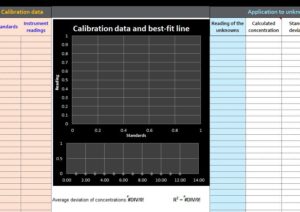
Calibrating for accuracy, whether you need to accurately measure chemical compositions from the other more known compositions or use various types of spectroscopy to arrive at your answer, the free Calibration Quadratic B can help you in a snap. This template has everything you need to accurately enter your concentrations standard and watch as the template automatically calibrates your data with standard quadratic equations. This template is a useful tool for chemistry students to plot unreliable information to arrive at a much more accurate answer. Read the instructions below for more details.
Using the Calibration Quadratic B
At the center of the template, you will see a calibration data chart that creates a best-fit line when you plot your data. The line is intended to give you a much more accurate result based on your unreliable readings.
Start by entering your chemical concentrations and the readings your instruments gave you in the first two columns of the Calibration Quadratic B Template. You will then leave the remaining table sections blank in order for the Calibration Quadratic B Template to calculate your results.
For this template to work, you need to plot at least 5 examples for the calibration curve to give you a best-fit line (with a zero-concentration standard as well). Note that if you have a few readings with the same result, you should list them as different standards with the same figure so the template knows to weigh that value more significantly in the chart.
The next step is to list the readings of your unknown factors, such intensity, and absorbance. You can have up to 45 unknowns.
Your concentrations for the unknowns will be automatically calculated in the remaining 3 columns of the Calibration Quadratic B Template with your data displayed in the chart at the center of the page. You will receive the calculated concentration, standard deviation, and the relative percentage of the standard as well.
At any time, you can change any of the points to better enhance your results if you come up with better standards in your tests. The result should be a best-fit line that has better accuracy than your multiple deviations.
Download: Calibration Quadratic B Template
Thanks to T. O’Haver for his contribution
Check out this offer while you wait!

